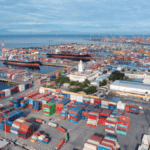- Home
- Trade News
- Strategy-Driven Upward Trends ...

The remarkable surge in exports of the Philippines in 2025 continue to defy global economic uncertainties and trade tensions. Export figures have climbed to signal short-term gains and a well-orchestrated strategy to strengthen the country’s standing in international trade.
While traditional top export sectors drive some of this momentum, a deeper look reveals a more calculated approach. The government’s focus on diversification, trade partnerships, and supply chain resilience is crucial in navigating a complex global market.
Philippines Exports Are Up YOY
The latest reports from the Philippine Statistics Authority (PSA) at the time of writing show the country’s export sales increasing 3.9% year-on-year (YOY). This growth highlights the country’s resilience amid global trade uncertainties and signals the potential for sustained momentum in the coming months.
While total external trade only grew by 0.4%, the export sector remains a bright spot in the nation’s economic landscape.
Total Export Sales
PSA likewise reports the Philippines’ total export sales reached USD 6.25 billion, up from USD 6.02 billion a year earlier. This rise was mainly driven by growing international demand for key commodities, including:
- Coconut oil posted the highest annual growth, adding USD 132.53 million
- Other manufactured goods, which rose by USD 106.09 million
- Electronic products, contributing an additional USD 87.05 million
Electronic products remained the Philippines’ top export, accounting for USD 3.52 billion, or 56.3% of total export earnings, further underscoring the nation’s critical role in the global electronics supply chain.
Export Value
The export value of Philippine goods saw a notable increase thanks to strong trade relationships with East Asia, which contributed the largest regional share at USD 2.96 billion (47.4% of total exports). Other key contributors included:
- Northern America: USD 1.03 billion (16.5%)
- Southeast Asia: USD 903.72 million (14.5%)
By country, the United States was the top individual trading partner, with exports valued at USD 986.84 million (15.8%), followed closely by:
- Japan: USD 984.76 million (15.7%)
- Hong Kong: USD 873.64 million (14.0%)
- China: USD 646.59 million (10.3%)
- Netherlands: USD 347.70 million (5.6%)
Additionally, APEC countries accounted for 80.5% of total exports, demonstrating the Philippines’ strong engagement within regional trade frameworks.
Narrowing Trade Deficit
According to a report published in April 2025, the Philippines’ trade gap narrowed by 11.4% to USD 3.16 billion, a promising shift driven by stronger exports and more disciplined import activity, particularly in non-essential goods like petroleum oils and machinery.
Leading this improvement was a 15.7% surge in merchandise exports, hitting USD 5.9 billion, largely due to a rebound in the electronics sector, especially semiconductors, which jumped 31.9% year-on-year to USD 2.65 billion. This sector alone accounted for over 63% of total export value, showing signs of a serious comeback.
There’s clear evidence of momentum, with top markets like Hong Kong, the US, and South Korea recording double-digit import growth from the Philippines. If this trend continues, it could help rebalance the country’s trade dynamics and reduce foreign dependency.
Strong Performance for Agricultural Exports
The Philippines exports a diverse range of agricultural products, and in 2025, the sector has demonstrated remarkable growth, reinforcing its position as a key driver of economic growth.
As global demand for sustainable and high-quality produce rises, the Philippines’ agricultural exports have notably increased, particularly in coconut oil, bananas, sugar, and pineapples.
However, challenges persist. Increasing competition from regional exporters, particularly in the Japanese and Southeast Asian markets, has pressured pricing and trade strategies. Nevertheless, strategic trade agreements and enhanced market access bolster the sector’s export potential.
Coconut Oil
The Philippines remains one of the world’s top exporters of coconut oil, a staple in the global food, cosmetics, and biofuel industries. In 2025, exports of coconut oil surged, driven by:
- Rising global demand for plant-based oils as an alternative to petroleum oils
- Increased purchasing from Europe and North America, where coconut oil is a key ingredient in health and beauty products
- A shift towards biofuels, particularly in markets like South Korea and the United States, where governments are pushing for renewable energy solutions
With the Philippines’ supply chain improving and production output stabilising, the nation’s coconut oil exports are expected to remain a major contributor to foreign exchange earnings in the coming months.
Bananas
The Philippines has long been a dominant force in the global banana trade, supplying key markets like Japan, China, and South Korea. However, in 2025, Philippine banana exporters faced increased competition from regional producers such as Ecuador and Vietnam, particularly in the Japanese market.
Despite this, the country has maintained a strong export performance, thanks to:
- Improved export quality standards, making Philippine bananas more competitive
- Ongoing trade talks with Japan, ensuring continued market access
- Expanding distribution networks, particularly in China and emerging Southeast Asian markets
With supply chain enhancements and incentives for banana producers, the Philippines’ banana industry is expected to remain a major export sector despite external pressures.
Sugar
The Philippines’ sugar exports have steadily increased in 2025, with supply partners like the United States maintaining a strong demand for raw sugar. The country recently fulfilled its quota allocation of 66,000 metric tonnes to the US market, further reinforcing its role as a key sugar exporter.
The growth in sugar exports can be attributed to:
- Favourable weather conditions, which boosted production output
- Government incentives for sugarcane farmers, increasing yields
- Rising global demand, particularly from North America and Europe
With stable production and expanding trade opportunities, the Philippines’ sugar exports are expected to maintain strong momentum throughout 2025.
Pineapples
The Philippines is among the top exporters of pineapples, with key markets including Japan, South Korea, and China. In 2025, pineapple exports increased by 7.5%, driven by higher production output and expanding demand from Asian and European buyers.
Key factors contributing to this growth include:
- Improved farming techniques, leading to higher-quality produce
- Greater market access, thanks to preferential trade agreements
- Rising demand for fresh and processed pineapples, particularly in the health-conscious consumer segment
Agriculture remains a core pillar of the Philippines’ export economy. The continued success of coconut oil, bananas, sugar, and pineapples highlights the sector’s resilience and ability to adapt to shifting global demands.
Other Top Export Products
Beyond agriculture, the Philippines’ exports heavily rely on manufactured goods, electronics, machinery, and minerals. These sectors continue to drive economic growth, with global demand for Philippine-made products increasing in 2025.
Interestingly, the tourism industry has also played a supporting role in international trade, as increased visitor arrivals have spurred demand for locally produced goods, boosting export sales.
Manufactured Goods
The Philippines’ manufactured goods sector remains a cornerstone of its export economy, contributing significantly to foreign exchange earnings. The country has continued to expand its industrial production capabilities, enabling it to supply a diverse range of export products, including:
- Plastic articles are widely used in packaging and consumer goods
- Medical apparatuses are growing due to the increasing demand for healthcare equipment worldwide
- Office machine parts continue to see stable demand in North America and Europe
By strengthening its industrial output, the Philippines ensures that its manufactured goods sector remains a key pillar of its export-driven economy.
Electronics
The electronics industry is one of the Philippines’ top export sectors, with electronic products accounting for a large share of total exports.
The demand for semiconductor devices, electronic integrated circuits, and insulated wires has remained strong, particularly from China, Japan, and the United States.
Key growth drivers in 2025 include:
- Rising global demand for semiconductor devices is essential for producing smartphones, laptops, and other consumer electronics.
- Increased chip manufacturing investment allows the Philippines to expand its production capabilities.
- Partnerships with global tech giants reinforce the nation’s position in the electronics supply chain.
With continued government support and trade incentives, the Philippines exported electrical machinery at a higher volume in 2025, strengthening its role as a critical player in the global electronics market.
Machinery and Transport Equipment
The Philippines exported machinery and transport equipment steadily in 2025, with East Asia and North America remaining its primary supply partners. The sector’s growth is driven by:
- Strong demand for industrial equipment, particularly from Southeast Asia and South Korea
- Expanding trade agreements, facilitating easier access to key export markets
- Innovations in manufacturing allow the nation to compete with larger exporters like China and Malaysia
With investments in high-value manufacturing, the Philippines’ machinery exports are expected to increase further, contributing positively to GDP growth.
Minerals
The mineral resources sector remains integral to the Philippines’ export economy, with precious metals and industrial minerals seeing steady demand. In 2025, the Philippines’ mining industry has focused on high-value exports, including:
- Copper ore and unrefined copper continue to be exported to China and India
- Copper alloys and copper foil are used in various industrial applications
- Iron and steel slag are in high demand in construction and manufacturing
A major development in 2025 is the Philippines’ pitch to India for nickel exports, specifically for use in battery production. With India expanding its electric vehicle (EV) industry, the Philippines is strategically positioning itself as a key supplier of nickel, which is crucial for lithium-ion battery production.
As the global market shifts towards renewable energy, the Philippines’ mineral exports are expected to play an even bigger role in meeting international demand.
Top Export Partners
The Philippines’ exports continued to thrive in 2025, thanks to strong trade relationships with key international markets. Despite geopolitical uncertainties and global economic shifts, the Philippines has maintained strong trade partnerships, helping to drive economic growth and meet foreign exchange needs.
United States
The United States remains one of the Philippines’ top export destinations. However, the recent increase in US tariffs on select goods has posed challenges for Filipino exporters.
Despite this, the Department of Trade and Industry (DTI) remains optimistic, citing diversification strategies and preferential trade agreements to mitigate the impact.
Key Philippine exports to the US include:
- Electronic integrated circuits and semiconductor devices are crucial for the US tech industry
- Machinery and transport equipment, particularly office machine parts and insulated wires
- Medical apparatus continues to see high demand in the healthcare sector
While exporters adapt to the new trade landscape, the Philippines’ economic resilience and strong US-Philippines bilateral trade relations are expected to keep exports steady.
Japan
Japan remains a major export partner of the Philippines, with trade relations deeply rooted in historical economic cooperation. However, increased competition from other Southeast Asian nations, particularly in agricultural products like bananas and pineapples, has pressured Philippine exporters.
Despite this, the Philippines continues to supply Japan with:
- Coconut oil, widely used in the Japanese food and cosmetic industry
- Electronic products, particularly computer accessories and electrical equipment
- Copper ore and copper alloys used in Japan’s industrial sector
With ongoing trade dialogues between both governments, efforts are being made to ensure that Philippine exports remain competitive in the Japanese market.
Hong Kong, China, and the Netherlands
The Philippines has strengthened its presence in Hong Kong, China, and the Netherlands, diversifying its export portfolio across multiple regions.
- China remains a key buyer of the Philippines’ mineral resources, including unrefined copper, steel slag, and iron and steel slag.
- Hong Kong remains a strategic hub for re-exporting Philippine electronic products, particularly semiconductor devices and integrated circuits.
- The Netherlands, known for its strong port infrastructure, is a key entry point for Philippine agricultural exports into Europe.
Expanding its market reach, the Philippines ensures stable export growth while reducing reliance on a single supply partner.
APEC
As a member of the Asia-Pacific Economic Cooperation (APEC), the Philippines continues to benefit from regional trade agreements and economic partnerships. APEC has played a crucial role in:
- Facilitating trade negotiations, making it easier for the Philippines to export goods across member economies.
- Promoting supply chain resilience, especially for electronic products and machinery.
- Providing platforms for preferential trade agreements, such as the ongoing discussions with India and the UK.
With APEC’s continued support, the Philippines is well-positioned to expand its export markets while ensuring sustainable economic growth.
Adaptive Export Strategy
Despite volatile global trade policies and rising protectionist measures, the Philippines has demonstrated resilience and adaptability in its export strategies.
The country is positioning itself for sustainable economic growth while meeting its foreign exchange needs by navigating regulatory challenges, diversifying markets, and negotiating new trade agreements.
Raw Ore Ban
The Philippine government has proposed a ban on raw ore exports, aiming to boost local industries and promote value-added processing. This move is expected to:
- Encourage local production of refined mineral products, such as copper foil, unrefined copper, and non-iron mineral resources.
- Strengthen the domestic manufacturing sector, particularly in electrical machinery and semiconductor devices.
- Enhance the country’s competitiveness by exporting processed metals instead of raw materials, similar to Indonesia’s nickel export strategy.
However, this shift has sparked debate among industry stakeholders, with some arguing that the immediate loss of raw ore exports could impact short-term revenue streams.
The government believes long-term benefits outweigh the risks, as refining and processing minerals locally will generate higher export value.
Downgraded Export Targets
The Philippines has been forced to revise its export targets downward due to the latest US tariff adjustments, which have placed additional pressure on key export products such as:
- Electrical machinery facing new tariff rates in the US tech sector
- Machinery, including office machine parts and computer accessories, is now subject to stricter import regulations
Philippines export data reveals a decline in trade volume with the US in early April 2025, prompting adjustments in economic forecasts.
Despite these setbacks, officials remain optimistic, pointing to diversification efforts and new trade negotiations as mitigating factors.
Push for Preferential Trade Agreement With India
The Philippines has intensified efforts to secure a preferential trade agreement with India in response to changing trade dynamics. This is particularly strategic given India’s growing demand for:
- Nickel and copper alloys essential for India’s expanding battery and renewable energy sectors
- Electronic products, including integrated circuits and semiconductor devices, critical for India’s tech industry
- Medical apparatuses and industrial machinery catering to India’s rapidly growing healthcare and infrastructure sectors
By strengthening ties with India, the Philippines aims to reduce reliance on traditional markets while unlocking new trade opportunities in South Asia.
Enhanced Bilateral Trade With the UK
Another key element of the Philippines’ adaptive export strategy is its deepening economic relationship with the UK. With both nations seeking to enhance bilateral trade, discussions have focused on:
- Lowering trade barriers for Philippine export products such as coconut oil, plastic articles, and petroleum oils
- Facilitating technology transfers, particularly in accounting services, finance, and renewable energy industries
- Strengthening export ties in machinery and transport equipment, including non-iron industrial components
This UK-Philippines trade partnership represents a major opportunity for Filipino exporters to diversify their supply partners and increase their total European exports.
Conclusion: The Philippines’ Export Sector at a Turning Point
The Philippines may be celebrating back-to-back export growth, but a storm is brewing. The US has just imposed a 17% tariff on Philippine goods, lumping the country into a sweeping trade crackdown that targets all 10 ASEAN economies.
As one of the Philippines’ top export destinations, the US move could dent demand for key goods, and with protectionism on the rise and economic power dominating international relations, can the Philippines deepen ties with East Asia and diversify its trade partners, or will it face hard consequences for relying too heavily on traditional markets?
For businesses and traders looking to obtain reliable insights into Philippines export data, understanding supply partners, and tracking market trends, having access to comprehensive trade intelligence is essential. At TradeDataPro, we provide the latest data, in-depth analytics, and expert perspectives to help businesses navigate the complexities of international trade.








